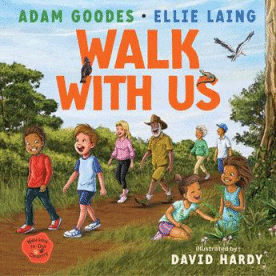
Walk With Us: Welcome to Our Country
Walk With Us: Welcome to Our Country
Adam Goodes
Ellie Laing
David Hardy
A & U Children’s, 2023
32pp., hbk., RRP $A24.99
9781761065071
When Harvey and his mum go for a walk in their favourite park, they are invited to walk with indigenous Elder Uncle Boris and learn about the wonders of the Cammeraygal (North Sydney) land on which they are treading. From the healing powers of the leaf of the tologurã (lemon myrtle ), to the wildlife near the waterfall and even seeing a large canoe tree, mother and son see and learn things that they have passed by many times but have taken for granted. Harvey has already astonished his mum by reciting the Acknowledgement of Country that he has learned at school, and now both of them develop not only a new insight into the significance of their surroundings but also experience a sense of calm and tranquility as they view the landscape with new eyes and absorb its significance..
Based on a phrase in the final line of the Uluru Statement from the Heart – We invite you to walk with us in a movement of the Australian people for a better future – this is the fourth in this brilliant series designed to teach both children and adults a little more of the meaning behind those now-familiar words of the Acknowledgement of Country. Using people and symbols that are important to them (these are explained on the verso page). the authors have crafted a simple but significant story that will encourage young (and not-so) readers to start to look at their surroundings through a different lens. Who walked this Country before I did? What did they know about it that I could learn?
As with the previous titles, this starts with a visual glossary of indigenous words for the familiar items featured in the story, and given that October 22-29 marks the inaugural Aboriginal Languages Week in NSW, it would seem appropriate to compare the words of the Cammeraygal people for things such as fire, snake, wallaby, frog and so forth to the words used by local peoples, perhaps even starting to construct your own visual glossary.
In my opinion, this series is one of the most significant publications available to help our young children understand and appreciate the long-overdue recognition of our First Nations people in schools, so that when they hear a Welcome to Country or participate in an Acknowledgement of Country or even just take a walk through their neighbourhood, they do so with a new knowledge of and respect for all that has gone before.
